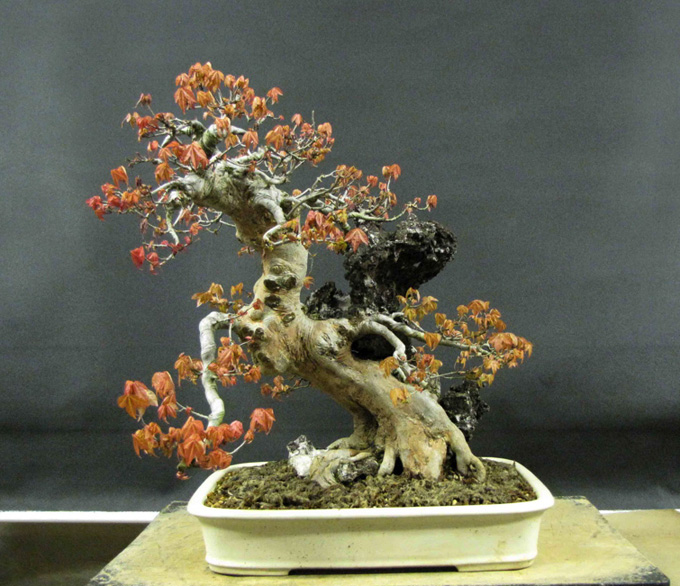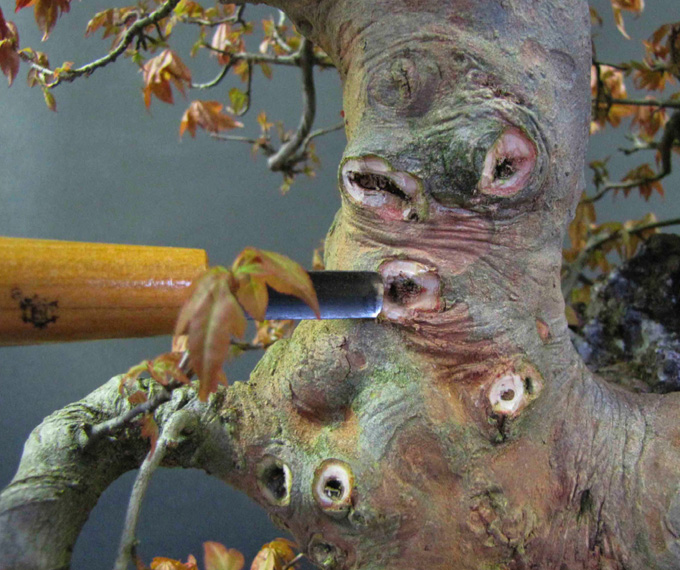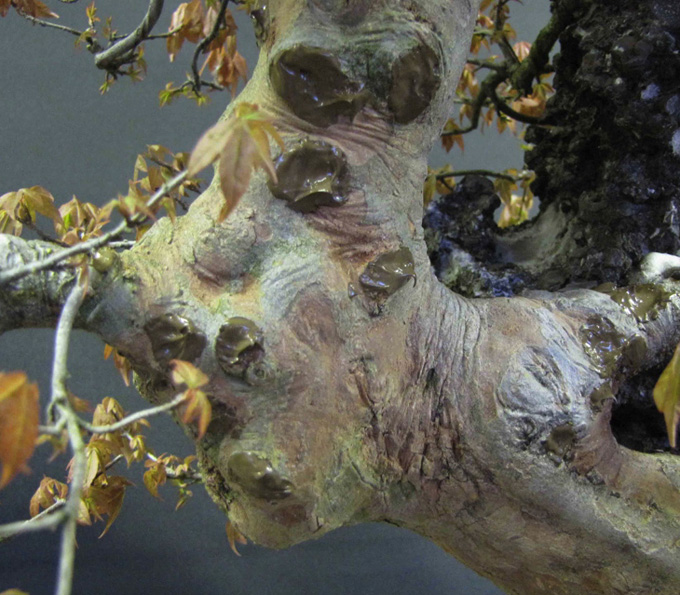 One of Peter Tea’s freshly worked-on Trident maples. You’ll have to use your imagination to get a feel for what this tree will look like when it fills out. But if your imagination fails you, it still looks pretty good, just as it is.
One of Peter Tea’s freshly worked-on Trident maples. You’ll have to use your imagination to get a feel for what this tree will look like when it fills out. But if your imagination fails you, it still looks pretty good, just as it is.
Borrowing from Peter…
Once again, we are borrowing from Peter Tea’s excellent bonsai blog. This time it’s a story of two Trident maples. We’ll just whet your appetite here; for a whole series of instructive photos and insightful text, you can visit Peter’s blog.
Cut paste versus the natural way
Here is the West some people are eschewing the use of cut paste on tree wounds. The theory is that fresh air and sunlight are the best healers. It’s a pretty good theory if you don’t care about scarring. However, if you want to control how scar tissue forms and how scars look after healing, then the use of cut paste is important. The same can be said for cutting and carving techniques. We won’t go into all the details here, but we will offer a glimpse (from Peter’s blog) into the use of carving and cut paste to heal wounds.
 The other Trident maple after Peter applied his deft touches. You can see the before shots for this one and the one above on Peter’s blog.
The other Trident maple after Peter applied his deft touches. You can see the before shots for this one and the one above on Peter’s blog.
 Removing old scars. I particularly like what Peter is doing here. In his own words… “As I cleaned the bark, I noticed some old small scars. I’m not a big fan of scars on Trident Maples so I’m going to get these scars to heal up. Some Bonsai enthusiast out there likes to show off scars and dead wood on Tridents but I think these small scars are more distracting then interesting. What I did was taking a small carving too and re open the scars. By doing this, the tree will sense the open wound and want to heal itself. I did this to all the small scars I could find on the trunk… (continued below next photo).
Removing old scars. I particularly like what Peter is doing here. In his own words… “As I cleaned the bark, I noticed some old small scars. I’m not a big fan of scars on Trident Maples so I’m going to get these scars to heal up. Some Bonsai enthusiast out there likes to show off scars and dead wood on Tridents but I think these small scars are more distracting then interesting. What I did was taking a small carving too and re open the scars. By doing this, the tree will sense the open wound and want to heal itself. I did this to all the small scars I could find on the trunk… (continued below next photo).
 “Next thing I did was cover the fresh wounds with cut paste. This step is important because the tree will heal much faster this way. Just think of a cut on your finger and using a band aid. Using a band aid always makes a cut heal faster. If I don’t use cut past, the wound will start to heal but may not close completely leaving me with what I had before. I expect these scars to heal by Summer.”
“Next thing I did was cover the fresh wounds with cut paste. This step is important because the tree will heal much faster this way. Just think of a cut on your finger and using a band aid. Using a band aid always makes a cut heal faster. If I don’t use cut past, the wound will start to heal but may not close completely leaving me with what I had before. I expect these scars to heal by Summer.”
You can visit Peter Tea’s blog for the rest of the story.
Good food for thought.
RE tree number one: I have a problem with deciduous trees that are styled like pines. A Naka-ism.
re the cut paste: that sure doesn’t look like cut paste:more like Kiyonal or Lac Balsam. Wound dressing retains a small amount of moisture, which helps promote callus formation. This is the one thing that is unique to the dressings we use in bonsai (even Elmer’s Glue), as opposed to the usual tree sealer. The latter is proven to be ineffective. A prominent scientist concluded that since the dressings he tried don’t help, none of them, help. This is just bad science, as his conclusions can only apply to the ones he tried. I won’t name names, even though I know it.
The more occlusive sealers helped in the South keep out a mite that fed on callus. The most occlusive just might keep sap streak and other diseases out of the wound, especially if sterilized B4 closure.
After reading this article, I would like to make a minor but important point. I have been a professional arborist for twenty two years and one of the things I learned is that trees do not heal. Trees grow callus or wound wood to cover the wound to stop decay.
People and animals heal. Healing is a process of mending by replacing tissue.
Good observation – it isn’t cut paste. I spent some time at Aichi-en with Peter and Mr. Tanaka, and was surprised to see that they use joint caulk to seal most wounds. That is what Peter put on this trident.
There is a pic of the stuff the use here: http://lakeshorebonsai.wordpress.com/2012/02/28/expensive-japanese-cut-paste-is-it-a-waste-of-money/
Thanks Terry,
Thanks for you insightful comments. You’ve provided more food for thought.
I think once the Trident leafs out, it will look a bit more like a deciduous tree.
There seems to be some confusion about both terminology (cut paste, wound dressing, tree sealer, sealant, you can probably come up with others), and when and how to use sealants. Now you have introduced occlusive and sterilization to further sweeten the pot.
I won’t say more, except that there’s a somewhat raging discussion on the topic going on here: http://forums2.gardenweb.com/forums/load/bonsai/msg031325211091.html?32
Thanks Mike,
Good point. However, I think usage may trump your more narrow definition of the word ‘heal.’
Thanks LSBonsai.
I still use kyinol and other bonsai sealants. But then, we sell it. Fortunately, it’s a small fraction of our business, so even if everyone were to switch to less expensive alternatives, we’ll be okay.